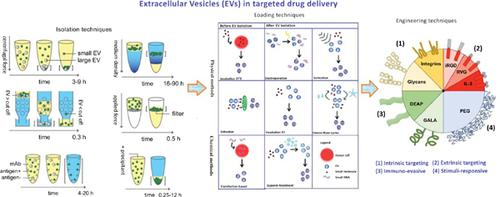Current Topics in Medicinal Chemistry ( IF 2.9 ) Pub Date : 2020-09-30 , DOI: 10.2174/1568026620666200922113054 Le-Yi Zhang 1 , Xue Yang 2 , Shi-Bing Wang 2 , Hong Chen 3 , Hong-Ying Pan 2, 4 , Zhi-Ming Hu 2, 5

|
Extracellular vesicles (EVs) are membrane vesicles (MVs) playing important roles in various cellular and molecular functions in cell-to-cell signaling and transmitting molecular signals to adjacent as well as distant cells. The preserved cell membrane characteristics in MVs derived from live cells, give them great potential in biological applications. EVs are nanoscale particulates secreted from living cells and play crucial roles in several important cellular functions both in physiological and pathological states. EVs are the main elements in intercellular communication in which they serve as carriers for various endogenous cargo molecules, such as RNAs, proteins, carbohydrates, and lipids. High tissue tropism capacity that can be conveniently mediated by surface molecules, such as integrins and glycans, is a unique feature of EVs that makes them interesting candidates for targeted drug delivery systems. The cell-derived giant MVs have been exploited as vehicles for delivery of various anticancer agents and imaging probes and for implementing combinational phototherapy for targeted cancer treatment. Giant MVs can efficiently encapsulate therapeutic drugs and deliver them to target cells through the membrane fusion process to synergize photodynamic/photothermal treatment under light exposure. EVs can load diagnostic or therapeutic agents using different encapsulation or conjugation methods. Moreover, to prolong the blood circulation and enhance the targeting of the loaded agents, a variety of modification strategies can be exploited. This paper reviews the EVs-based drug delivery strategies in cancer therapy. Biological, pharmacokinetics and physicochemical characteristics, isolation techniques, engineering, and drug loading strategies of EVs are discussed. The recent preclinical and clinical progresses in applications of EVs and oncolytic virus therapy based on EVs, the clinical challenges and perspectives are discussed.
中文翻译:

膜衍生的囊泡作为靶向药物递送系统的仿生载体。
细胞外囊泡(EVs)是膜囊泡(MVs),在细胞间信号转导以及将分子信号传递给邻近及远处细胞的各种细胞和分子功能中起重要作用。源自活细胞的MV中保留的细胞膜特性,使其在生物学应用中具有巨大潜力。电动汽车是从活细胞分泌的纳米级颗粒,在生理和病理状态下的几种重要细胞功能中都起着至关重要的作用。电动汽车是细胞间通讯的主要元素,在其中它们充当各种内源性货物分子(如RNA,蛋白质,碳水化合物和脂质)的载体。可以通过表面分子(例如整联蛋白和聚糖)方便地介导的高组织嗜性能力,电动车的独特功能使其成为目标药物输送系统的有趣候选者。细胞来源的巨MV已被用作载体,用于输送各种抗癌剂和成像探针,以及用于目标癌症治疗的组合光疗。巨型MV可以有效地封装治疗药物,并通过膜融合过程将其递送至靶细胞,从而在光照下协同进行光动力/光热处理。电动汽车可以使用不同的封装或结合方法装载诊断剂或治疗剂。而且,为了延长血液循环并增强所加载试剂的靶向性,可以利用多种修饰策略。本文回顾了基于电动汽车的癌症治疗中的药物输送策略。生物,讨论了电动汽车的药代动力学和理化特性,分离技术,工程和载药策略。讨论了电动汽车的应用和基于电动汽车的溶瘤病毒治疗的最新临床前和临床进展,临床挑战和前景。











































 京公网安备 11010802027423号
京公网安备 11010802027423号